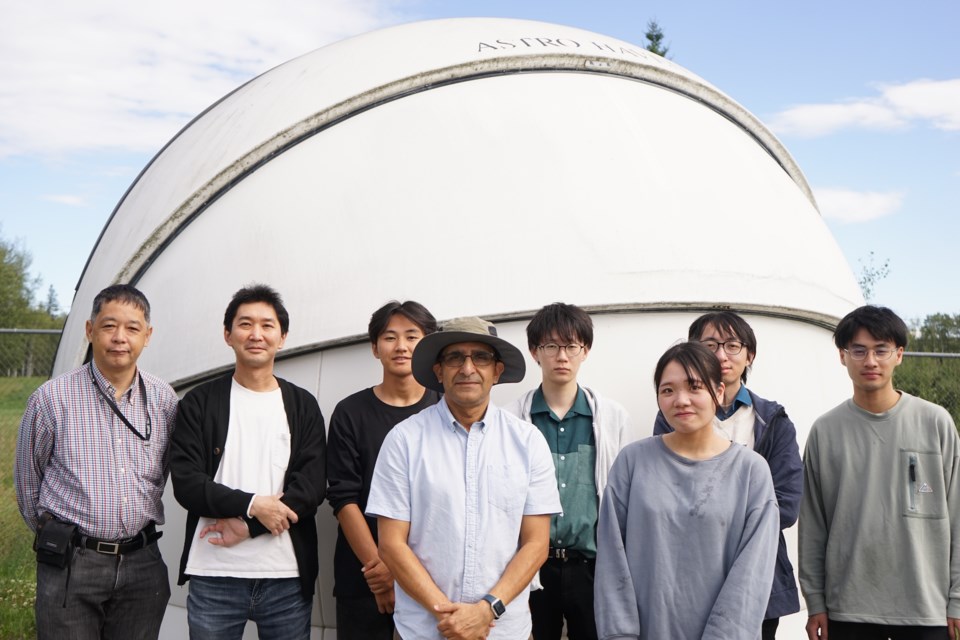ATHABASCA — Many of those who call the Athabasca region home would likely describe the area as a special one. Nestled in and around the river valley on the edge of the Boreal forest, the town and its surroundings hold many wonders of the natural world, obvious to any who bothers to look.
The diverse range of wildlife, the various shades of green which fade to brilliant yellows, reds, and oranges in the fall, and the wide expanse of the meandering Athabasca River are only three of the features that make Athabasca a one-of-a-kind destination in a province renowned for its natural beauty.
According to Dr. Martin Connors, a professor of astronomy, mathematics, and physics at Athabasca University (AU) for the last 28 years, Athabasca is in a special place for a new type of research he is starting with researchers from Japan.
Proton auroras, also known as blob auroras, are the subject of a new project for Connors and teams of researchers from Nagoya University and the National Institute for Polar Research at the University of Tokyo.
Because of Athabasca County’s latitude and dark skies, the distance university is in the perfect spot to study the more faint and lesser-known type of aurora.
“It looks different than ordinary auroras,” said Connors in a Sept 4 interview. “It just looks like a blobby cloud, and when I’ve seen them often they are pulsating, but slowly. It’s not very impressive-looking, it’s just different.”
Typically spotted in the southern sky as opposed to the northern sky, proton auroras differ from their regular, more widely known counterparts in more ways than only visual. But exactly how they differ and the potential effects of proton auroras are what Connors and the Japanese researchers are hoping to find out.
“Even ordinary auroras, there are still a few questions about how exactly they happen,” said Connors. “With proton auroras, in fact, in the simplest theories, they can’t even happen. They’re impossible.”
But with data from a Japanese spacecraft, Connors said their research has discovered one crucial part of the proton aurora recipe is a certain type of waves in space, and these waves can be detected from the ground.
“You might say, ‘Ok, well, we see a glow in the sky, and who cares?’ But we also find that sometimes the protons come lower down than usual, and then they could affect the upper atmosphere, and in particular, destroy ozone.”
In addition to learning more about how proton auroras occur, the new research will also be geared towards measuring the height of the light events to determine if, how often, and to what degree Earth’s atmosphere is impacted.
A team of seven Japanese scientists and students were in Athabasca this August to install new equipment in two university observatories that will be involved in capturing data for the research.
New cameras, which will take high-resolution images of the night sky during auroras, were put in the geophysical observatory on campus, as well as the observatory in the Meanook National Wildlife Area.
The timing of the research project is a result of the intersection of technological advancements, Athabasca’s positioning, and the 11-year cycle of the sun’s magnetic field. As the solar maximum approaches, auroras are more frequent, and as bigger and better equipment is developed to capture them, costs drop.
“The cameras we're using now are quite powerful and quite inexpensive,” said Connors. “You’re talking about six to 10 cameras, and it used to be they were multiple thousands of dollars each.
“Now, they’re a few hundred dollars each, so we can just go nuts on pointing cameras at auroras and get a lot of data.”
AU has been working in conjunction with Japanese researchers for more than 20 years, and Connors said the distance university is working to open up opportunities for Canadian students at York University in the future.
“This is a great opportunity for the Japanese students, and they enjoy coming to Canada,” said Connors. “We were able to go swimming the other day and it was great, so Athabasca County has a lot that can attract people as far away as Japan.”



